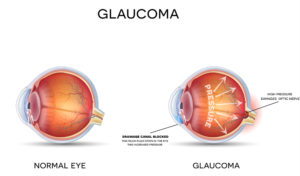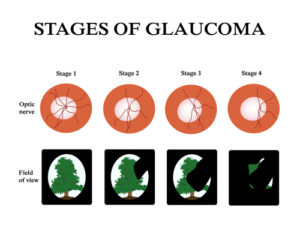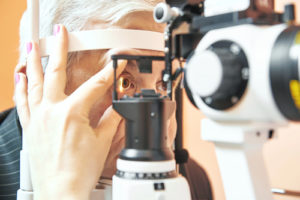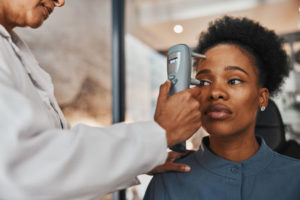Glaucoma is currently one of the leading causes of blindness worldwide, affecting both men and women, from newborns to the elderly. After AMD (age-related macular degeneration), it is the second leading cause of blindness in industrialized countries.
In Switzerland, 100,000 people have been diagnosed with this disease, while another 100,000 are not yet diagnosed. In France, 600,000 people suffer from it, but 400,000 remain undetected.
Understanding glaucoma, its symptoms, and the importance of screening is essential to protect your vision. In this article, we will explore what you need to know to preserve your sight against this silent but devastating disease.
Glaucoma: A Condition Not to Be Taken Lightly
Glaucoma is a degenerative eye disease that causes the progressive destruction of the optic nerve, which is essential for vision. Vision loss occurs insidiously, starting at the periphery and gradually moving toward the center of the visual field. Without treatment, this condition can lead to blindness.
Glaucoma is characterized by an abnormal increase in intraocular pressure. This phenomenon results from a dysfunction in the drainage of the aqueous humor, a fluid present in the eyeball. Excessive pressure damages nerve fibers, which play a crucial role in transmitting light information from the retina to the brain.
The Role of Intraocular Pressure
Glaucoma is often linked to elevated intraocular pressure (IOP), which can compress and damage the fibers of the optic nerve and retina. In adults, normal IOP ranges between 10 and 21 mmHg, with an average around 16 mmHg.
This pressure depends on the volume of aqueous humor in the anterior chamber of the eye. The aqueous humor is produced by the ciliary body in the posterior chamber, then passes through the pupil to the anterior chamber. It is then absorbed by the drainage system located in the iridocorneal angle, passing through the trabecular meshwork and Schlemm’s canal before joining the bloodstream.

Different Forms of Glaucoma
Glaucoma can take several forms, each with distinct mechanisms. The most common form is chronic open-angle glaucoma.
- Primary Glaucomas:
- Chronic Open-Angle Glaucoma: Represents between 80% and 90% of cases. It is the most frequent form.
- Acute Angle-Closure Glaucoma: A rare form of glaucoma, but it can cause rapid vision loss if not treated urgently.
- Secondary Glaucomas: These are linked to ocular conditions or general diseases, such as ocular inflammations, diabetes, or thrombosis.
- Childhood Glaucomas: Often hereditary, they present in several forms:
- Early Infantile Glaucoma: Affects newborns.
- Infantile Glaucoma: Concerns children up to one year old.
- Juvenile Glaucoma: Affects older children and adolescents.
What Are the Symptoms of Glaucoma?
Acute Glaucoma
Acute glaucoma manifests suddenly and usually affects only one eye. Symptoms include intense pain, a red and hard eye, and the perception of colored halos around lights, accompanied by decreased vision. It is an ophthalmological emergency. Without treatment, vision can be lost within a few hours due to elevated intraocular pressure. This type of glaucoma particularly affects elderly and/or hyperopic individuals.
Chronic Glaucoma
Unlike acute glaucoma, chronic glaucoma progresses slowly and without symptoms over years, sometimes between 10 and 20 years. It affects both eyes unevenly, which can delay diagnosis because one eye often compensates for the other. Symptoms, when they appear, usually indicate an advanced stage of the disease. These may include peripheral vision loss, halos around lights, and difficulty following a moving object. Without management, chronic glaucoma can lead to ocular pain and significant vision loss.

It is essential to understand that vision loss caused by glaucoma is irreversible. That’s why early screening is crucial to preserve your vision and prevent blindness. Here are the recommended screening frequencies:
- Every three years for people over 40.
- Every two years for people over 50.
- Every year for people over 60.
Regular screening is key to detecting glaucoma at an early stage, allowing for prompt and effective treatment.
Risk Factors for Glaucoma: What You Need to Know
The exact cause of glaucoma is often unknown. However, certain factors increase the risk of developing this disease. These include:
- Age
- Family history of glaucoma
- Ethnic origin
- Ocular hypertension
These factors are frequently observed in people with glaucoma. Knowing these risk elements can help you be more vigilant and plan regular screenings with your ophthalmologist.

In addition to age and family history, other factors can also increase the risk of developing glaucoma:
- High myopia or hyperopia
- Diabetes
- Prolonged use of steroids: These medications can increase intraocular pressure by acting on the sympathetic system and may trigger a glaucoma attack.
If you have any of these risk factors, early screening is highly recommended to prevent complications and protect your vision.
How Is Glaucoma Diagnosed?
An ophthalmologist performs examinations to detect glaucoma and monitor its progression. It is essential to consult regularly, especially if you are at risk.

Screening Techniques
Glaucoma screening relies on several examinations that assess intraocular pressure, the structure of the optic nerve, and the visual field. The main ones include:
- Tonometry: Measures intraocular pressure without contact using a puff of air.
- Fundus Examination: Conducted with a large magnifying lens to analyze the condition of the optic nerve.
- Visual Field Assessment: Measures the surrounding space you can see without moving your eyes, detecting potential peripheral vision loss.
- Examination of the Iridocorneal Angle: Determines if the glaucoma is open-angle or angle-closure by observing the angle between the iris and the cornea.
These examinations allow for early and essential screening to protect your vision against glaucoma.
Intraocular Pressure Examination: A Key Indicator for Glaucoma Diagnosis
The examination of intraocular pressure (IOP) is crucial for diagnosing and monitoring eye diseases, particularly glaucoma. IOP is the pressure exerted by the fluid inside the eye. Assessment is typically done using a tonometer, an instrument that measures pressure by applying slight force on the eye. This examination is vital for early detection of anomalies, allowing for rapid intervention and prevention of irreversible vision damage.
In Conclusion
After this quick overview of glaucoma and its symptoms, it is clear that regularly consulting an ophthalmologist is essential for screening. If glaucoma is detected early, you can benefit from effective and minimally invasive treatments that can stop or slow the disease’s progression.
For cases where initial treatments are not sufficient, advanced surgical solutions—such as those offered by Rheon Medical—are available and performed by experienced surgeons as you can see in this video.
Have questions ? Contact-us
